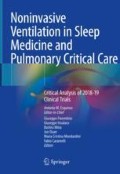Abstract
Monitoring a patient in long-term non-invasive ventilation (LTNIV) requires the availability and the wide knowledge of tools such as nocturnal pulse oximetry, polysomnography/polygraphy (PSG/PG), capnography and arterial blood gas analysis (ABG). During the last few years, some manufacturers have incorporated in their ventilators special softwares that are able to detect, during non-invasive ventilation (NIV), respiratory parameters such as air leaks, residual apnoeic/hypopnoeic events and the patient’s daily compliance in the ventilator’s utilization. The clinician’s skills are then necessary for the cautious evaluation and interpretation of this data in order to improve the ventilator’s settings.
Access this chapter
Tax calculation will be finalised at checkout
Purchases are for personal use only
References
Sanders MH, Kenn N. Obstructive sleep apnea treated by independently adjusted inspiratory and expiratory positive airway pressures via nasal mask. Physiologic and clinical implications. Chest. 1990;98:317–24..
Janssens JP, Derivaz S, Breitenstein E, et al. Changing patterns in long-term non-invasive ventilation: a 7 years prospective study in the Geneve lake area. Chest. 2003;123:67–79.
Tsolaki V, Pastaka C, Kostinas K, et al. Non-invasive ventilation in chronic respiratory failure: effects on quality of life. Respiration. 2011;81:402–10.
Amin R, Sayal P, Syed F, et al. Pediatric long-term home mechanical ventilation: twenty years of follow-up from one Canadian center. Pediatr Pulmonol. 2014;49(8):816–24.
Punjabi NM, Newman AB, Young TB, et al. Sleep-disordered breathing and cardiovascular disease: an outcome-based definition of hypopneas. Am J Respir Crit Care Med. 2008;177(10):1150–5.
Fu ES, Downs JB, Schweiger JW, et al. Supplemental oxygen impairs detection of hypoventilation by pulse oximetry. Chest. 2004;126(5):1552–8.
Gonzalez C, Ferris G, Diaz J, et al. Kyphoscoliotic ventilatory insufficiency: effect of long-term intermittent positive-pressure ventilation. Chest. 2003;124(3):857–62.
Berry RB, Chediak A, Brown LK, et al. NPPV titration task force of the american academy of sleep medicine. Best clinical practices for the sleep center adjustement of non-invasive positive pressure ventilation (NPPV) in stable chronic alveolar hypoventilation syndromes. J Clin Sleep Med. 2010;6(5):491–509.
Rabec C, Georges M, Kabeya NK, et al. Evaluating non-invasive ventilation using a monitoring system coupled to a ventilation: a bench-to-bedside study. Eur Respir J. 2009;34(4):902–13.
Contal O, Vignaux L, Combescure C, et al. Monitoring of a non-invasive ventilation by built-in software of home bilevel ventilators: a bench study.Chest 2012;141(2):469–76.
Pasquina P, Adlen D, Farr P, et al. What does built-in software of home ventilators tell us? An observational study of 150 patients on home ventilation. Respiration. 2012;83(4):293–9.
Borel JC, Sabil A, Janssens JP, et al. Intentional leaks in industrial masks have a significant impact on efficacy of bilevel non-invasive ventilation: a bench test study. Chest. 2009;135(3):669–77.
Gonzales-Bermejo J, Janssens JP, Pepin JL, et al. Proposal for a systematic analysis of polygraphy or polysomnography for identifying and scoring abnormal events occurring during non-invasive ventilation. Thorax. 2012;67(6):546–52.
Sanders MH, Kern N. Obstructive sleep apnea treated by independently adjusted inspiratory and expiratory positive airway pressures via nasal mask. Chest 1990;98(2):317–24.
Author information
Authors and Affiliations
Corresponding author
Editor information
Editors and Affiliations
Rights and permissions
Copyright information
© 2020 Springer Nature Switzerland AG
About this chapter
Cite this chapter
Rao, F. (2020). Using Domiciliary Noninvasive Ventilator Data Downloads to Inform Clinical Decision-Making to Optimize Ventilation Delivery and Patient Compliance. In: Esquinas, A.M., et al. Noninvasive Ventilation in Sleep Medicine and Pulmonary Critical Care. Springer, Cham. https://doi.org/10.1007/978-3-030-42998-0_12
Download citation
DOI: https://doi.org/10.1007/978-3-030-42998-0_12
Published:
Publisher Name: Springer, Cham
Print ISBN: 978-3-030-42997-3
Online ISBN: 978-3-030-42998-0
eBook Packages: MedicineMedicine (R0)

